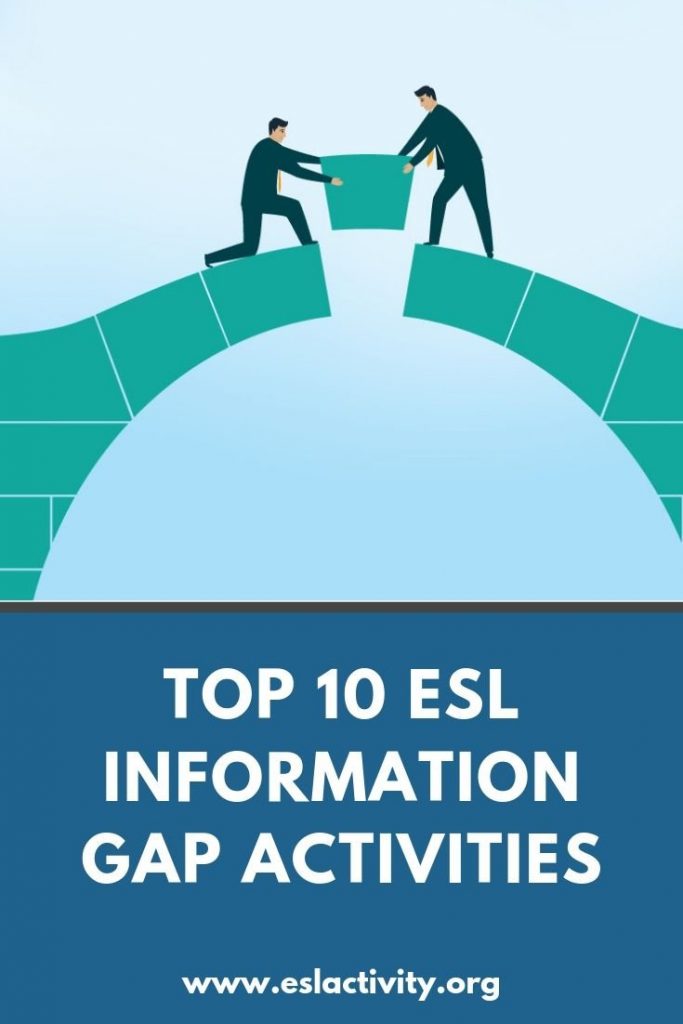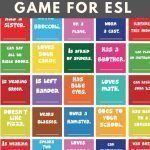I’m ALL about information gap activities in my classes. They’re ideal for teaching in South Korea, and in other places where the students are a little bit shy because they force the students to talk to each other.
Basically, the way an ESL information gap activity works is that each student has some information, but has to get different information from someone else to complete the activity. This is the purest form.
However, you could loosely consider things like surveys to be information gap activities as well. Or, something like a vocabulary guessing game. This is because they require the answers or hints of other students to complete the assignment, although in this case, you’re not specifically looking for any one answer.
Information Gap Activity: What is it?
An information gap activity is where language learners each have some, but not all of the information needed to complete a task. In order to get all the information, students have to talk to each other. For example, Learner A may have information about the weather and industry of a country, but Learner B has details about hobbies and geography.
Information Gap Activities ESL

ESL Information Gap Activities
I’m going to share with you some of my favourite information gap activities to try out with your English learners. Let’s get to it!
#1: Draw This
For this information gap activity in English, one student has a picture and the other one has a pencil and blank piece of paper. The student with the picture has to describe to the other student what to draw. The results? Usually hilarious!
It’s ideal for working on numbers, shape names in English, and adjectives with your students (big/small/long, etc.).
You should be careful about choosing the picture though. The best ones are of an alien or monster, or a place like a house or map. Of course, don’t choose a picture of someone in this class!
Find out more details here: https://eslspeaking.org/draw-a-picture/.
#2: ESL Surveys
If you ask my students, they’ll tell you that I LOVE to do surveys in my classes. For most conversation or speaking courses, I’ll do them around once a month or once every three weeks. They cover a wide range of skills and lend themselves well to a variety of topics.
As far as the information gap aspect goes, students have to ask their classmates questions to find someone who answers “yes.” Then, they ask some follow-up questions related to that to find more information.
To find out more, check out this out: Surveys for the ESL Classroom.
#3 Information Gap Activities: Find Something in Common ESL Icebreaker
The information gap for this activity is related to the fact that students need to find out details about each other that they have in common. For intermediate or advanced level students, once they find this information, they can have a short conversation about it.
It’s a great icebreaker for the first day of class. I particularly love it for classes where nobody knows each other because it can really help to break the ice.
Check it out here: Find Something in Common Icebreaker.
#4: Guessing Game Vocabulary Review Activity
This information gap activity is an ideal way to review new vocabulary words, and it works best for smaller classes of beginners. The way it works is that a team is trying to describe a certain word to their captain without using actions or actually saying the word itself.
It’s a fun party game and makes a nice review before a test of some kind. It makes a nice ESL body part activity.
You can find out more about it here: ESL Vocabulary Review Game.
#5: Just One Question Warmer
This ESL warm-up requires students to formulate a question and then ask their classmates for their opinions about it. The information gap is that students don’t know what their classmates are going to say about it and have to ask them to find out.
It’s a fun way to introduce a new topic and it gets the students up and out of their seats, moving around the classroom. Learn more about it here: Just One Question.
#6 Information Gap Activities ESL: 20 Questions
Although more of a game than an activity, 20 questions is fun to play with your ESL or EFL students. The gap comes in where 1 person knows the “answer” and the rest of the students are trying to figure out what it is by asking questions.
I adapt the classic version a little bit, depending on the level of the students. Find out how I do this here:
#7:Menu Ordering
Create two different restaurant menus, each with unique dishes. One student takes on the role of the waiter and the other the customer. The customer asks questions about the menu items and places an order based on their preferences.
#8 Information Gap Activity ESL: Running Dictation
Running dictation is a classic 4-skills activity that definitely fits into the category of information gap game or activity. One person reads the sentences around the classroom and has to tell that information to their partner who writes it down.
This ESL activity is one that you should try out with your classes today, if you haven’t already. It’s a great way to students energized and having fun while learning English at the same time.
Check it out here: ESL Running Dictation.
#9: Puzzle Finder
This fun activity forces students to talk to each other because you can’t complete the activity without doing so! It’s one of the best icebreakers for high beginners and up. The students have to work together to solve the puzzle. Check it out here:
#10: Find the Differences
Give each pair of students a slightly different picture or scene. One student describes their picture to the other, who must listen carefully and draw what they hear. Afterward, they compare their drawings to find the differences.
#11: Lost in the City
Create a map or a grid with various landmarks and locations in a city. One student has the map and the other has a list of directions. The student with the directions must guide their partner to specific locations by giving clear instructions.
#12: Travel Plans
Students are planning a trip, but each student has different information about destinations, transportation options, and activities. They must communicate and exchange information to come up with a joint travel plan.
#13: Weather Report
Provide each pair of students with different weather information for various cities. One student acts as a weather reporter and the other as a listener. The reporter describes the weather in different cities while the listener asks questions to determine which city is being described.
#14: News Report
Give each pair of students different news articles with missing information. One student reads the article aloud while the other student listens and asks questions to gather the missing information.
Some More Classic Information Gap Activities English
Besides the ones on this list, there are some other classic activities to try out. They include:
- Maps and Directions: students have to give directions to the other person to find something.
- Complete the story: have two versions of the same story, but with different pieces of information removed. Students have to work together to get the complete picture.
- Charts: For example, an ESL family tree. Each student has some information and they have to work together to make the big picture.
- Guess the job/animal, etc.: Try out this classic party game in your classes. Paste a sticky note with a word so that the student can’t see what it is. They have to ask questions to the other students to try to uncover the answer.
- Find your Match: Each student has a card and there are two of them throughout the class. Keeping the cards secret, they have to ask other students yes/no questions to find their match.
Information Gap Activity Worksheets
If you’re looking for a ready-made solution, then consider using some information gap activity worksheets. This is my favourite source: ISL Collective.

Why are information gap activities important when teaching speaking?
Why are Information Gap Activities Important in Teaching Speaking?
An information gap activity has a number of advantages. They can help to increase motivation because students have a reason for communicating—they have to talk to each other to complete a task. You can use information gap activities for pair, group or entire class interactions which can add some variety to your language lessons.
Do you like these ESL Information Gap Activities?
- Amazon Kindle Edition
- Bolen, Jackie (Author)
- English (Publication Language)
- 187 Pages - 03/09/2016 (Publication Date)
Yes? Thought so. Then you’re going to love this book: 101 ESL Activities for Teenagers and Adults. We all know that the key to fun, engaging English classes is a variety of interesting activities. However, this isn’t always easy to put into practice in real life when we busy and tired towards the middle and end of the semester.
Available in a Variety of Formats
That’s why you need this book on the bookshelf in your office as a handy reference guide. Or, a copy on your phone for lesson planning at your favourite coffee shop. It really is that easy to make your English lessons even better with some of these fun, engaging games and activities.
Organized into Various Sections
The best part is that the book is so well organized into various sections: 4-skills, speaking, review, writing, etc. so that you’ll be able to find what you need in minutes. Then, man y of the activities require very little in the way of preparation. The result? Fun, engaging classes that won’t cause you any stress!
Get your Copy Today
Check out 101 ESL Activities for yourself over on Amazon, but only if you want to get yourself some serious ESL awesome:
FAQs
There are a number of common questions that people have about using info gap games and activities in the classroom. Here are the answers to some of the most popular ones.
Why are information gap activities beneficial for English learners?
Information gap activities promote active communication, listening, and problem-solving skills. They provide authentic and meaningful contexts for language practice.
What language skills do information gap activities help develop?
Information gap activities help develop speaking, listening, reading, and sometimes writing skills. They encourage students to use the target language in a practical and interactive way.
How do information gap activities enhance language learning?
Information gap activities enhance language learning by fostering communication, encouraging students to negotiate meaning, and increasing their exposure to real-life language use.
What are some advantages of using information gap activities in the classroom?
Information gap activities promote student engagement, collaboration, critical thinking, and creativity. They also provide opportunities for students to practice fluency, accuracy, and problem-solving skills.
What types of tasks can be used as information gap activities?
Various tasks can be used, such as describing pictures, sharing information, solving puzzles, giving directions, ordering items, interviewing, and role-playing scenarios.
How can information gap activities be adapted for different proficiency levels?
Information gap activities can be adapted by adjusting the complexity of the information provided, the language structures required, and the level of support given. Simplifying or adding challenges can accommodate different proficiency levels.
Are information gap activities more suitable for pair work or group work?
Information gap activities can be done in pairs or small groups, depending on the task and class dynamics. Pair work allows for more individual participation, while group work encourages collaboration and discussion.
Can information gap activities be used in online or remote teaching?
Yes, information gap activities can be adapted for online or remote teaching. They can be done through video conferencing platforms, shared documents, or interactive online tools that facilitate communication and information exchange.
What are some tips for implementing information gap activities effectively?
Provide clear instructions, monitor and facilitate the activity, encourage active participation, provide feedback, and create a supportive and inclusive learning environment. It’s also important to select tasks that are meaningful and relevant to the learners’ interests and needs.
Have your Say about these Information Gap Activities
Do you have any go-to information gap activities ESL? Or, have you tried out any of the info gap games and activities from this list? How did it go? Leave a comment below and let us know what you think. We’d love to hear from you.
Also be sure to give this article a share on Facebook, Pinterest, or Twitter. It’ll help other busy teachers, like yourself find this useful teaching resource.

Information Gap Activities ESL students
Last update on 2022-07-17 / Affiliate links / Images from Amazon Product Advertising API





